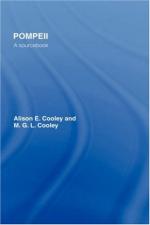|
This section contains 315 words (approx. 2 pages at 300 words per page) |
The Street Scape of Pompeii and Herculaneum
Pompeii covers over 67 hectares and over four, fifth's of it have been excavated. Pompeii has a typical structure of roman towns, as the alleyways are narrow. The roads excavated have deep wheel groves caused by streams of heavy way on. This sort of evidence shows us that Pompeii was a commercial town. The main road of Pompeii was called "Via dell Abondanza" meaning the road of plenty. The streets of Pompeii had footpaths and drainage was poor with stepping stones placed so people could cross during rain.
Herculaneum covers 22 hectares and only 2/5 have been excavated. The streetscape shows us that Herc was not as populated as pom as the roads were not worn in. Unlike Pom, Herc had storm drains and an efficient underground sewer.
Both towns' streetscapes divide the towns into neat rectangular blocks called Insulae. Each contained 1-12 dwellings including houses, apartment blocks and shops. They also had Aqueducts that brought the cities water supply. These pipes supplied street fountains, public baths, swimming pools and public water towers. There were private wells and every house had a water tank. Public toilets were common but only the rich had private ones.
Both towns contained the following, Forum-city centre, political debates, gossips, religious ceremonies, market days and private and public notices were placed on parals called Alba. Basilica-the town hall located near the forum was used to house all legal and government businesses. Ministers had the offices, commercial and entertainment licenses were issued and law cases heard. Major temples, dedicated to town gods, Amphitheatres- sport stadiums- provided blood sport entertainment. Theatres-dramatic performances, palaestra-gyms, and Public baths- only the rich had there own baths and everyone else used public baths. Public baths consisted of cold, steam and hot baths, massages were also available. There were large commercial areas, which consisted of shops though Pomp had particular areas for commerce.
|
This section contains 315 words (approx. 2 pages at 300 words per page) |


